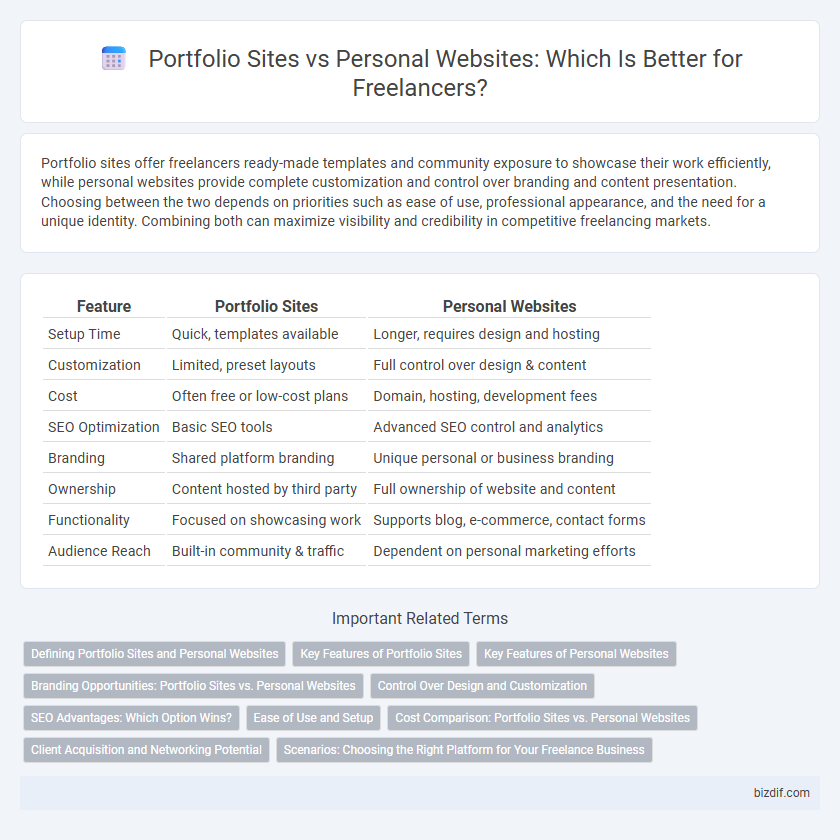Portfolio sites offer freelancers ready-made templates and community exposure to showcase their work efficiently, while personal websites provide complete customization and control over branding and content presentation. Choosing between the two depends on priorities such as ease of use, professional appearance, and the need for a unique identity. Combining both can maximize visibility and credibility in competitive freelancing markets.
Table of Comparison
| Feature | Portfolio Sites | Personal Websites |
|---|---|---|
| Setup Time | Quick, templates available | Longer, requires design and hosting |
| Customization | Limited, preset layouts | Full control over design & content |
| Cost | Often free or low-cost plans | Domain, hosting, development fees |
| SEO Optimization | Basic SEO tools | Advanced SEO control and analytics |
| Branding | Shared platform branding | Unique personal or business branding |
| Ownership | Content hosted by third party | Full ownership of website and content |
| Functionality | Focused on showcasing work | Supports blog, e-commerce, contact forms |
| Audience Reach | Built-in community & traffic | Dependent on personal marketing efforts |
Defining Portfolio Sites and Personal Websites
Portfolio sites are specialized platforms showcasing freelancers' work samples, skills, and project achievements to attract clients. Personal websites offer broader content, including biographies, blogs, and contact information, reflecting the freelancer's brand and personality. Both serve essential roles in establishing online presence, with portfolio sites emphasizing visual proof of expertise and personal websites highlighting individual narratives and professional identity.
Key Features of Portfolio Sites
Portfolio sites offer specialized templates designed to showcase freelance work through high-quality visuals, client testimonials, and project case studies that highlight skills and expertise effectively. These platforms often include built-in tools for easy updates, SEO optimization, and integration with social media to attract potential clients. Customizable galleries, user-friendly navigation, and analytics features further enhance the visibility and impact of a freelancer's body of work compared to personal websites.
Key Features of Personal Websites
Personal websites offer complete customization, allowing freelancers to showcase unique branding, integrate diverse multimedia content, and control SEO strategies to attract targeted clients. They enable direct communication through personalized contact forms and can host client testimonials, project case studies, and blogs that demonstrate expertise. Unlike portfolio sites, personal websites provide greater flexibility in design, domain ownership, and content management without platform restrictions.
Branding Opportunities: Portfolio Sites vs. Personal Websites
Portfolio sites offer streamlined templates optimized for showcasing work samples, enabling freelancers to highlight their skills with minimal design effort, which enhances brand visibility quickly. Personal websites provide full creative control, allowing freelancers to integrate custom branding elements such as logos, color schemes, and personalized content that convey a unique professional identity. Choosing between a portfolio site and a personal website impacts branding opportunities by balancing ease of use and customization to effectively attract and retain clients.
Control Over Design and Customization
Freelancers gain significant control over design and customization when using personal websites compared to portfolio sites, which often impose templates and limited design options. Personal websites allow tailored branding, unique layouts, and integration of advanced features that align with specific professional goals. This customization enhances user experience and effectively showcases a freelancer's skills and personality.
SEO Advantages: Which Option Wins?
Portfolio sites offer built-in SEO tools, domain authority from established platforms, and higher chances of ranking on search engines due to their structured templates and frequent updates. Personal websites provide complete control over SEO elements such as meta tags, keyword targeting, and content customization, which can lead to stronger brand identity and tailored search engine visibility. For freelancers prioritizing SEO, personal websites often win by enabling more precise optimization strategies and unique content that stands out in search results.
Ease of Use and Setup
Portfolio sites offer user-friendly templates and drag-and-drop interfaces, enabling freelancers to quickly showcase their work without technical skills. Personal websites demand more time and a basic understanding of web design or coding but provide greater customization and control over content. Choosing between the two depends on balancing ease of setup with the desire for a unique online presence.
Cost Comparison: Portfolio Sites vs. Personal Websites
Portfolio sites generally offer lower upfront costs with subscription plans typically ranging from $8 to $30 per month, making them cost-effective for freelancers who prefer ready-made templates and built-in hosting. Personal websites require initial investments such as domain registration (around $10-$15 per year), hosting fees ($3-$10 per month), and potentially web development costs, offering greater customization but higher overall expenses. For freelancers evaluating cost efficiency, portfolio sites minimize setup and maintenance expenses, while personal websites provide long-term value through full control and branding flexibility.
Client Acquisition and Networking Potential
Portfolio sites offer streamlined client acquisition by showcasing curated work samples and client testimonials, increasing trust and conversion rates. Personal websites provide greater networking potential through customizable content, blogs, and integrated social media, allowing freelancers to build authority and engage with niche communities. Combining both platforms maximizes exposure and diversifies client leads across various digital channels.
Scenarios: Choosing the Right Platform for Your Freelance Business
Freelancers seeking to showcase diverse projects and attract a wide client base often benefit from portfolio sites like Behance or Dribbble due to their built-in audiences and community features. Personal websites offer complete customization and brand control, ideal for freelancers aiming to establish a unique identity and integrate blogs, testimonials, or e-commerce options for expanded client engagement. Selecting between portfolio platforms and personal websites depends on factors such as desired visibility, technical skills, and long-term business goals in freelancing.
portfolio sites vs personal websites Infographic

 bizdif.com
bizdif.com